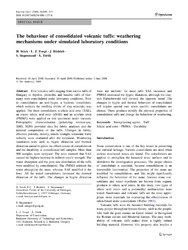The behaviour of consolidated volcanic tuffs: weathering mechanisms under simulated laboratory conditions
Stück, H.
Forgó, L. Z.
Rüdrich, J.
Siegesmund, S.
Török, Á.
56, 3/4: 699 - 713
DOI: https://doi.org/10.1007/s00254-008-1337-6
Persistent URL: http://resolver.sub.uni-goettingen.de/purl?gldocs-11858/6736
Persistent URL: http://resolver.sub.uni-goettingen.de/purl?gldocs-11858/6736
Stück, H.; Forgó, L. Z.; Rüdrich, J.; Siegesmund, S.; Török, Á., 2008: The behaviour of consolidated volcanic tuffs: weathering mechanisms under simulated laboratory conditions. In: Stück, H.; Forgó, L. Z.; Rüdrich, J.; Siegesmund, S.; Török, Á. (2008): The behaviour of consolidated volcanic tuffs: weathering mechanisms under simulated laboratory conditions - Environmental geology; Vol. 56, Nr. 3/4, p. 699-713, DOI: 10.1007/s00254-008-1337-6.
 |
Dokument öffnen: |
Five volcanic tuffs ranging from dacitic tuffs of Hungary to rhyolite, phonolite and basaltic tuffs of Germany were consolidated under laboratory conditions. Prior to consolidation an anti-hygro, a hydrous consolidant, which reduces the swelling ability of clay minerals, was applied. The three consolidants, a silicic acid ester (SAE), an elastic silicic acid ester (eSAE) and an acrylate resin (PMMA) were applied on test specimens under vacuum. Petrographic characterisation (polarizing microscopy, XRD, SEM) provided data for fabric analyses and the mineral composition of the tuffs. Changes in fabric, effective porosity, density, tensile strength, ultrasonic wave velocity were evaluated after the treatment. Weathering simulation tests such as hygric dilatation and thermal dilatation aimed to prove the effectiveness of consolidation and the durability of consolidated tuff samples. More than 500 samples were analysed. The tests showed that SAE caused the highest increase in indirect tensile strength. The water absorption and the pore size distribution of the tuffs were modified by consolidation. The PMMA reduced the water absorption the most, whereas SAE modified it the least. All the tested consolidants increased the thermal dilatation of the tuffs. The changes in hygric dilatation were not uniform: for most tuffs SAE increased and PMMA decreased the hygric dilatation, although the clay-rich Habichtswald tuff showed the opposite trend. The changes in hygric and thermal behaviour of consolidated tuff require special care when specific consolidants are chosen. These products modify the physical properties of consolidated tuffs and change the behaviour of weathering.
Statistik:
ZugriffsstatistikSammlung:
- Geologie [931]

